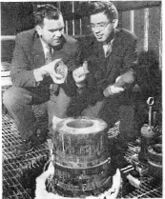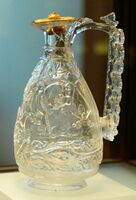مرو (حجر)
| مرو أو كوارتز | |
|---|---|
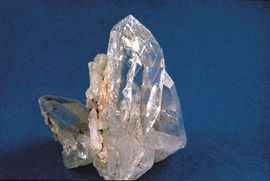
| |
| عام | |
| الصنف | معدن |
| الصيغة الكيميائية (or التركيب) | سيليكا (ثاني أكسيد السيليكون, SiO2) |
| التمييز | |
| اللون | صافي (إذا انعدمت الشوائب); also see Varieties |
| عادة التبلور | 6-sided prism ending in 6-sided pyramid (typical) |
| نظام التبلور | سداسي |
| Cleavage | None |
| الشرخ | Conchoidal |
| مقياس موز للصلادة | 7 - lower in impure varieties |
| البريق | Vitreous/glossy |
| معامل الإنكسار | 1.544-1.553 - DR +0.009 (B-G interval) |
| Pleochroism | None |
| تعريق | أبيض |
| الوزن النوعي | 2.65 constant; variable in impure varieties |
| نقطة الإنصهار | 1650 (±75) °C |
| نقطة الغليان | 2230 °C |
| قابلية الذوبان | H2O غير قابل للذوبان |
| أنواع التواجد | |
| خلقدوني | Any cryptocrystalline quartz, although generally only used for white or lightly coloured material. Otherwise more specific names are used. |
| عقيق Agate | Banded Chalcedony, translucent |
| مرمر | Agate where the bands are straight, parallel and consistent in size. |
| بشب Jasper | Opaque chalcedony, impure |
| Aventurine | Translucent chalcedony with small inclusions (usually mica) that shimmer. |
| Tiger's eye | Fibrous quartz, exhibiting chatoyancy. |
| بلور صخري | Clear, colourless |
| كوارتز ياقوتي | Crimson glass-like crystal, absorbs vast amounts of solar energy |
| جمشت Amethyst | Purple, transparent |
| Citrine | Yellow to reddish orange, greenish yellow |
| Prasiolite | أخضر نعناعي, شفاف |
| كوارتز وردي, translucent, قد يبدو عليه diasterism | |
| كوارتز حليب, أو كوارتز الثلج | White, translucent to opaque, may display diasterism |
| كوارتز مدخن | Brown, transparent |
| Morion | Dark-brown, opaque |
| Carnelian | Reddish orange chalcedony, ذاتي الإضاءة |
المرو أو الكوارتز (Quartz) هي ثاني أكثر مادة متوفرة على سطح الأرض. تتكون من بلورات سداسية الشكل والتي تتكون بدورها من سيلكا ثلاثية التبلور (ثاني أوكسيد السيلكون SiO2). يتميز بألوان متعددة حيث هناك الكوارتز الوردي والأسود والشفاف وغيرهم وذلك نتيجة اختلاف التركيب الشبكي واختلاف نسبة وأنواع الشوائب.
صلابته تقدّر بـ 7 على مقياس موس. تبلغ كثافته 2.6 غم/سم3. ويسمي الكوارتز كيميائيا بثاني اكسيد السيلكون (الرمل) SiO2 ويتميز الكوارتز ببريق لا فلزي زجاجي.
إستخداماته
ويستخدم المرو في تصنيف الصخور النارية حيث تعد الصخور النارية التي تحوي نسبة عالية من الكوارتز (> 66%) صخور نارية حمضية وكلما قلت نسبة السليكا (المرو) تصبح هذة الصخور قاعدية. ومن الصعب ايجاد المرو والأليفين في صخور ناري واحد بسبب أن درجة انصهار وتجمد كل واحد منهما تختلف عن الاخر حيث تتكون بلورات المرو عند درجات حرارة عالية حسب سلسلة بون للتفاعلات الكيميائية. ويستخدم الكوارتز في صناعة الزجاج والكريستال وادوات المائدة وكذلك البصريلت, وتدخل الانواع عالية النقاء من الكوارتز في الصناعات الالكترونية مثل صناعة السليكونات التى تدخل في صناعة الكمبيوتر ومعظم الاجهزة الالكترونية.
يمكن العثور على المرو في أشكال عديدة، وفي أنواع الصخور الثلاثة الرئيسية: النارية والمتحولة والرسوبية. وباستثناء سليكات الألومنيوم، يعد المرو من أكثر المواد الداخلة في تركيب الصخور توافراً في القشرة القارية للأرض. وهو يُعد أيضاً من أكثر المعادن صلابةً، ومن المعادن القليلة التي تفوقه في الصلابة البريل والأسنبيل والتوباز والياقوت والماس. ولايؤثر التآكل في المرو بالسرعة التي يؤثر بها في معظم المواد الصخرية.
الأنواع
هناك العديد من أنواع المرو، وغالباً ما يقسمها الجيولوجيّون إلى مجموعتين عامتين، هما: الخشنة التَّبَلُّر والخفية التبلر. أما الأشكال الخشنة التبلر من المرو فتشمل البلّورات السداسية الجوانب شبه المنشورية، والكتل الحبيبية الكبيرة، التي يمكن فيها رؤية حبيبات المرو المفردة. ويعد البلور الصخري مرواً خشن التبلر، ويوجد في شكل بلورات نقية لا لون لها. ويطلق على بعض الأنواع الملونة من بلورات المرو الخشن التبلر، مثل الجمشت والسيترين، اسم التوباز الزائف، وهي تقطع إلى أحجار كريمة. والأشكال الحبيبية من المرو الخشن التبلر تشمل الحجر الرملي المروي والرمل المروي. ويعد المرو الوردي والمرو الحليبي من الأشكال الحبيبية الملونة.
وينشأ لون نوع ما من أنواع المرو الخشن التلبر عن مقادير صغيرة من الألومنيوم والكالسيوم والحديد والليثيوم والمغنسيوم والصوديوم وغيرها من العناصر في تركيبها البلوري. فعلى سبيل المثال، ينجم اللون البنفسجي الضارب إلى الزرقة، الذي يُميز الجمشت عن وجود الحديد والمغنسيوم، وقد ينجم التلون كذلك عن تغيرات أو عيوب في التركيب البلوري للمرو. والمظهر الدخاني الذي يتّخذه الكيرنجورم الذي يدعى كذلك المرو الدخاني ينجم كذلك عن مثل هذه التغيرات. ويطلق تحلّل عنصر نشط إشعاعياً، مثل اليورانيوم والثوريوم في المرو طاقة إشعاعية نشطة تغير التركيب البلوري. وبسبب هذا التغيرلا يمكن لأشعة الضوء أن تتخلل البلورة، فينجم اللون الدخاني عن ذلك.
أما الأشكال الخفية التبلر فلها حبيبات مفردة من المرو، لايمكن رؤيتها إلا بالاستعانة بالمجهر. وتشمل هذه الأشكال العقيق الأبيض والسرت والظر واليشب. ويتألف الخشب المتحجر من العقيق الأبيض الذي حل محل الليف الخشبي الأصلي. والعقيق الأحمر والعقيق نوعان من العقيق الأبيض يستخدمان حلياً.
الخواص والاستخدامات
للمرو خاصية مهمة تسمى التأثير الكهروإجهادي. . فعندما تضغط صفيحة (شريحة) من المرو ميكانيكيًّا، فإنها تكتسب شحنةً موجبة من جانب، وسالبة من جانب آخر. وهذه الظاهرة هي توليد كهربائيّ إجهادي للجهد الكهربائي عبر البلورة. وهي تمكن تيّاراً كهربائيًا أو إشارةً كهربائيةً من المرور عبر البلورة. وتُستخدم بلورات المرو، في ناقلات الموجات الخاصة بأجهزة المذياع والتلفاز ومعظم الردارات. وفي مثل هذه الناقلات، تضخم الإشارة الكهربائية المولدة وتُغيَّر إلى موجة راديوية ذات تردد معيّن.
وهذ الخاصية المسماه بالكهروإجهادية، التي يتمتّع بها المرو، تتيح الأساس لتشغيل ساعات الحائط. والجهد الكهربائي الذي يُسلّط على شريحة بلورة المرو يجعل هذه الشريحة تتمدد وتنكمش، الأمر الذي يؤدي إلى إحداث ذبذبات بمعدّل منتظم. ويحدد حجم الشريحة عدد الذبذبات في كل ثانية، ثم تحوّل الذبذبات إلى ثوان ودقائق وساعات.
ولايتمدد المرو كثيراً، لدى تسخينه، كما أنّه لايتصدّع عندما يتمُّ تبريده بسرعة، وهذه الخواصُّ تجعل من المرو مادة مهمة في صنع الحاويات الزجاجية، التي يمكن أن تصمد في وجه درجات الحرارة الشديدة الارتفاع.
وتستخدم البلورة الصخرية في صنع العدسات لبعض التلسكوبات والمجاهر، وكما تستخدم بلورات المرو الكبيرة كذلك في صنع نبائط بصرية أخرى. ومعظم بلورات المرو المستخدمة لأغراض صناعية تُنتج بشكل اصطناعي بسبب الإمداد المحدود من البلورات الطبيعية. ويعدُّ حجر المرو الرملي مادة مألوفة من مواد البناء. ويستخدم رمل المرو في صنع الورق الرملي وأوراق الصنفرة والرُّحِي.
تنويعات (according to microstructure)
Although many of the varietal names historically arose from the color of the mineral, current scientific naming schemes refer primarily to the microstructure of the mineral. Color is a secondary identifier for the cryptocrystalline minerals, although it is a primary identifier for the macrocrystalline varieties.[1]
| ||||||||||||||||||||||||||||||||||||||||||||||||||||||||||||
معرض الصور
التاريخ
The word "quartz" comes from the German Quarz ,[2] which is of Slavic origin (Czech miners called it křemen). Other sources attribute the word's origin to the Saxon word Querkluftertz, meaning cross-vein ore.[3]
Quartz is the most common material identified as the mystical substance maban in Australian Aboriginal mythology. It is found regularly in passage tomb cemeteries in Europe in a burial context, such as Newgrange or Carrowmore in Ireland. The Irish word for quartz is grianchloch, which means 'sunstone'. Quartz was also used in Prehistoric Ireland, as well as many other countries, for stone tools; both vein quartz and rock crystal were knapped as part of the lithic technology of the prehistoric peoples.[4]
While jade has been since earliest times the most prized semi-precious stone for carving in East Asia and Pre-Columbian America, in Europe and the Middle East the different varieties of quartz were the most commonly used for the various types of jewelry and hardstone carving, including engraved gems and cameo gems, rock crystal vases, and extravagant vessels. The tradition continued to produce objects that were very highly valued until the mid-19th century, when it largely fell from fashion except in jewelry. Cameo technique exploits the bands of color in onyx and other varieties.
Roman naturalist Pliny the Elder believed quartz to be water ice, permanently frozen after great lengths of time.[5] (The word "crystal" comes from the Greek word κρύσταλλος, "ice".) He supported this idea by saying that quartz is found near glaciers in the Alps, but not on volcanic mountains, and that large quartz crystals were fashioned into spheres to cool the hands. This idea persisted until at least the 17th century. He also knew of the ability of quartz to split light into a spectrum.[6]
In the 17th century, Nicolas Steno's study of quartz paved the way for modern crystallography. He discovered that regardless of a quartz crystal's size or shape, its long prism faces always joined at a perfect 60° angle.[7]
Quartz's piezoelectric properties were discovered by Jacques and Pierre Curie in 1880.[8][9] The quartz oscillator or resonator was first developed by Walter Guyton Cady in 1921.[10][11] George Washington Pierce designed and patented quartz crystal oscillators in 1923.[12][13][14] Warren Marrison created the first quartz oscillator clock based on the work of Cady and Pierce in 1927.[15]
Efforts to synthesize quartz began in the mid nineteenth century as scientists attempted to create minerals under laboratory conditions that mimicked the conditions in which the minerals formed in nature: German geologist Karl Emil von Schafhäutl (1803–1890) was the first person to synthesize quartz when in 1845 he created microscopic quartz crystals in a pressure cooker.[16] However, the quality and size of the crystals that were produced by these early efforts were poor.[17]
By the 1930s, the electronics industry had become dependent on quartz crystals. The only source of suitable crystals was Brazil; however, World War II disrupted the supplies from Brazil, so nations attempted to synthesize quartz on a commercial scale. German mineralogist Richard Nacken (1884–1971) achieved some success during the 1930s and 1940s.[18] After the war, many laboratories attempted to grow large quartz crystals. In the United States, the U.S. Army Signal Corps contracted with Bell Laboratories and with the Brush Development Company of Cleveland, Ohio to synthesize crystals following Nacken's lead.[19][20] (Prior to World War II, Brush Development produced piezoelectric crystals for record players.) By 1948, Brush Development had grown crystals that were 1.5 inches (3.8 cm) in diameter, the largest to date.[21][22] By the 1950s, hydrothermal synthesis techniques were producing synthetic quartz crystals on an industrial scale, and today virtually all the quartz crystal used in the modern electronics industry is synthetic.[23]
Rock crystal jug with cut festoon decoration by Milan workshop from the second half of the 16th century, National Museum in Warsaw. The city of Milan, apart from Prague and Florence, was the main Renaissance centre for crystal cutting.[24]
Synthetic quartz crystals produced in the autoclave shown in Western Electric's pilot hydrothermal quartz plant in 1959
Fatimid ewer in carved rock crystal (clear quartz) with gold lid, c. 1000.
المصادر
أنظر أيضا
ملاحظات
- ^ "Quartz Gemstone and Jewelry Information: Natural Quartz – GemSelect". www.gemselect.com. Archived from the original on 29 August 2017. Retrieved 2017-08-29.
- ^ German Loan Words in English Archived 21 أغسطس 2007 at the Wayback Machine. German.about.com (2012-04-10). Retrieved 2013-03-07.
- ^ Mineral Atlas Archived 4 سبتمبر 2007 at the Wayback Machine, Queensland University of Technology. Mineralatlas.com. Retrieved 2013-03-07.
- ^ "Driscoll, Killian. 2010. Understanding quartz technology in early prehistoric Ireland". Archived from the original on 25 June 2017. Retrieved 19 July 2017.
- ^ Pliny the Elder, The Natural History, Book 37, Chapter 9. Available on-line at: Perseus.Tufts.edu Archived 9 نوفمبر 2012 at the Wayback Machine.
- ^ Tutton, A.E. (1910). "Rock crystal: its structure and uses". RSA Journal. 59: 1091. JSTOR 41339844.
- ^ Nicolaus Steno (Latinized name of Niels Steensen) with John Garrett Winter, trans., The Prodromus of Nicolaus Steno's Dissertation Concerning a Solid Body Enclosed by Process of Nature Within a Solid (New York, New York: Macmillan Co., 1916). On page 272 Archived 4 سبتمبر 2015 at the Wayback Machine, Steno states his law of constancy of interfacial angles: "Figures 5 and 6 belong to the class of those which I could present in countless numbers to prove that in the plane of the axis both the number and the length of the sides are changed in various ways without changing the angles; … "
- ^ Curie, Jacques; Curie, Pierre (1880). "Développement par compression de l'électricité polaire dans les cristaux hémièdres à faces inclinées" [Development, via compression, of electric polarization in hemihedral crystals with inclined faces]. Bulletin de la Société minéralogique de France. 3 (4): 90–93. doi:10.3406/bulmi.1880.1564.. Reprinted in: Curie, Jacques; Curie, Pierre (1880). "Développement, par pression, de l'électricité polaire dans les cristaux hémièdres à faces inclinées". Comptes rendus. 91: 294–295. Archived from the original on 5 December 2012. Retrieved 17 December 2013.
- ^ Curie, Jacques; Curie, Pierre (1880). "Sur l'électricité polaire dans les cristaux hémièdres à faces inclinées" [On electric polarization in hemihedral crystals with inclined faces]. Comptes rendus. 91: 383–386. Archived from the original on 5 December 2012. Retrieved 17 December 2013.
- ^ Cady, W. G. (1921). "The piezoelectric resonator". Physical Review. 17: 531–533. doi:10.1103/PhysRev.17.508.
- ^ "The Quartz Watch – Walter Guyton Cady". The Lemelson Center, National Museum of American History, Smithsonian Institution. Archived from the original on 4 January 2009.
- ^ Pierce, G. W. (1923). "Piezoelectric crystal resonators and crystal oscillators applied to the precision calibration of wavemeters". Proceedings of the American Academy of Arts and Sciences. 59 (4): 81–106. doi:10.2307/20026061. hdl:2027/inu.30000089308260. JSTOR 20026061.
- ^ Pierce, George W. "Electrical system," U.S. Patent 2٬133٬642, filed: 25 February 1924; issued: 18 October 1938.
- ^ "The Quartz Watch – George Washington Pierce". The Lemelson Center, National Museum of American History, Smithsonian Institution. Archived from the original on 4 January 2009.
- ^ "The Quartz Watch – Warren Marrison". The Lemelson Center, National Museum of American History, Smithsonian Institution. Archived from the original on 25 January 2009.
- ^ von Schafhäutl, Karl Emil (10 April 1845). "Die neuesten geologischen Hypothesen und ihr Verhältniß zur Naturwissenschaft überhaupt (Fortsetzung)" [The latest geological hypotheses and their relation to science in general (continuation)]. Gelehrte Anzeigen. München: im Verlage der königlichen Akademie der Wissenschaften, in Commission der Franz'schen Buchhandlung. 20 (72): 577–584. OCLC 1478717. From page 578: 5) Bildeten sich aus Wasser, in welchen ich im Papinianischen Topfe frisch gefällte Kieselsäure aufgelöst hatte, beym Verdampfen schon nach 8 Tagen Krystalle, die zwar mikroscopisch, aber sehr wohl erkenntlich aus sechseitigen Prismen mit derselben gewöhnlichen Pyramide bestanden. ( 5) There formed from water in which I had dissolved freshly precipitated silicic acid in a Papin pot [i.e., pressure cooker], after just 8 days of evaporating, crystals, which albeit were microscopic but consisted of very easily recognizable six-sided prisms with their usual pyramids.)
- ^ Byrappa, K. and Yoshimura, Masahiro (2001) Handbook of Hydrothermal Technology. Norwich, New York: Noyes Publications. ISBN 008094681X. Chapter 2: History of Hydrothermal Technology.
- ^ Nacken, R. (1950) "Hydrothermal Synthese als Grundlage für Züchtung von Quarz-Kristallen" (Hydrothermal synthesis as a basis for the production of quartz crystals), Chemiker Zeitung, 74 : 745–749.
- ^ Hale, D. R. (1948). "The Laboratory Growing of Quartz". Science. 107 (2781): 393–394. Bibcode:1948Sci...107..393H. doi:10.1126/science.107.2781.393. PMID 17783928.
- ^ Lombardi, M. (2011). "The evolution of time measurement, Part 2: Quartz clocks [Recalibration]" (PDF). IEEE Instrumentation & Measurement Magazine. 14 (5): 41–48. doi:10.1109/MIM.2011.6041381. S2CID 32582517. Archived (PDF) from the original on 27 مايو 2013. Retrieved 30 مارس 2013.
- ^ "Record crystal," Popular Science, 154 (2) : 148 (February 1949).
- ^ Brush Development's team of scientists included: Danforth R. Hale, Andrew R. Sobek, and Charles Baldwin Sawyer (1895–1964). The company's U.S. patents included:
- Sobek, Andrew R. "Apparatus for growing single crystals of quartz," U.S. Patent 2٬674٬520; filed: 11 April 1950; issued: 6 April 1954.
- Sobek, Andrew R. and Hale, Danforth R. "Method and apparatus for growing single crystals of quartz," U.S. Patent 2٬675٬303; filed: 11 April 1950; issued: 13 April 1954.
- Sawyer, Charles B. "Production of artificial crystals," U.S. Patent 3٬013٬867; filed: 27 March 1959; issued: 19 December 1961. (This patent was assigned to Sawyer Research Products of Eastlake, Ohio.)
- ^ خطأ استشهاد: وسم
<ref>غير صحيح؛ لا نص تم توفيره للمراجع المسماةbuisson-arnaud-1994 - ^ The International Antiques Yearbook. Studio Vista Limited. 1972. p. 78.
Apart from Prague and Florence, the main Renaissance centre for crystal cutting was Milan.
مراجع
- Hurlbut, Cornelius S.; Klein, Cornelis, 1985, Manual of Mineralogy, 20th ed., ISBN 0-471-80580-7
- Quartz varieties, properties, crystal morphology. Photos and illustrations
- Arkansas quartz, Rockhounding Arkansas
- Gilbert Hart Nomenclature of Silica, American Mineralogist, Volume 12, pages 383-395, 1927
- Queensland University of Technology Origin of the word quartz.
- PDF of Charles Sawyer's cultured quartz process description
- "The Quartz Watch - Inventors". The Lemelson Center, National Museum of American History. Smithsonian Institution.
- Terminology used to describe the characteristics of Quartz Crystals when used as oscillators
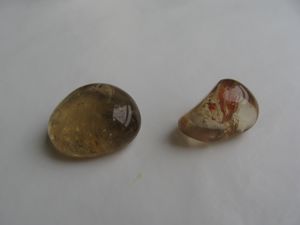
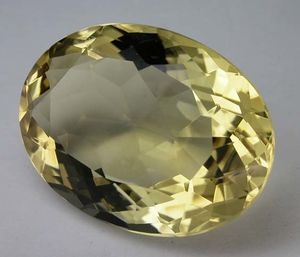



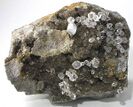



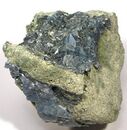
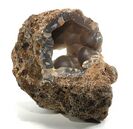

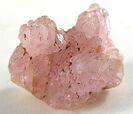

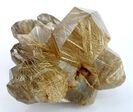


![Rock crystal jug with cut festoon decoration by Milan workshop from the second half of the 16th century, National Museum in Warsaw. The city of Milan, apart from Prague and Florence, was the main Renaissance centre for crystal cutting.[24]](/w/images/thumb/b/b9/Milan_Jug_with_cut_festoon_decoration.jpg/146px-Milan_Jug_with_cut_festoon_decoration.jpg)
